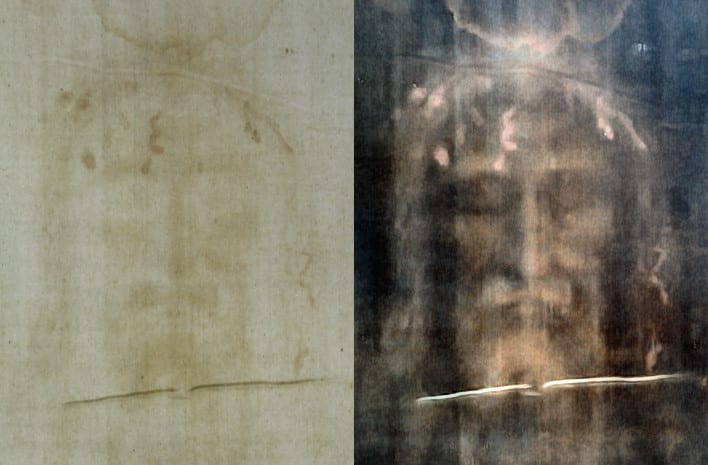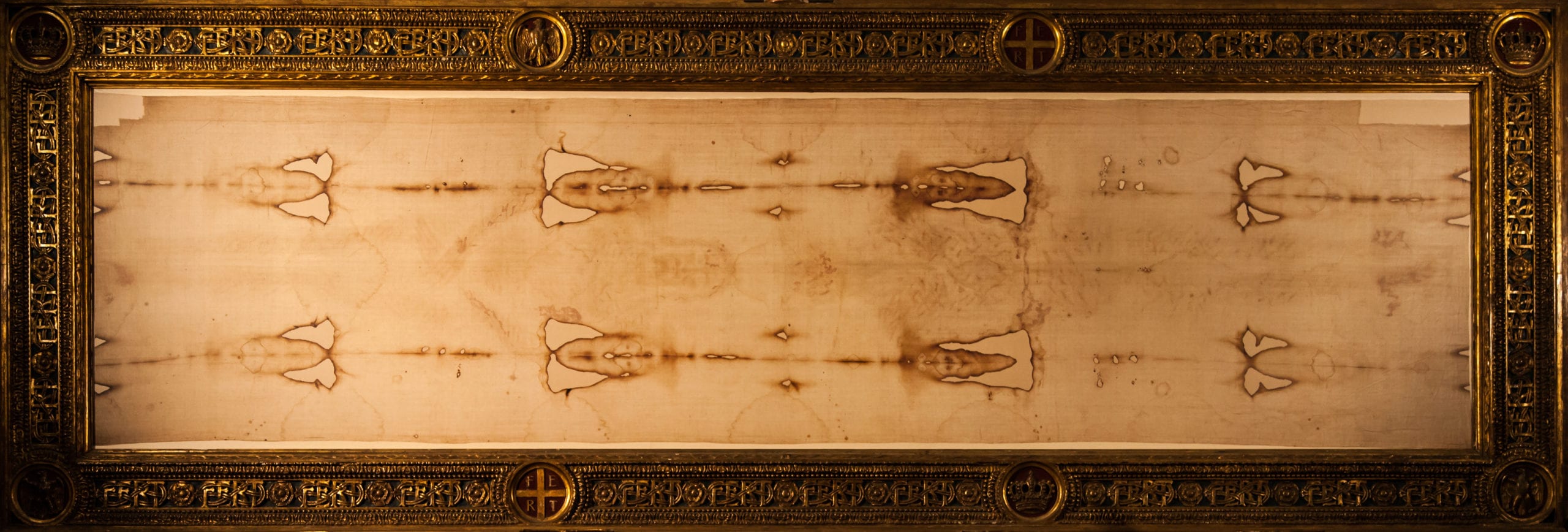It is a fourteen foot by five foot ancient linen cloth that bears a faint, straw-colored image of a prone, naked, crucified man. The image is most certainly that of Jesus although die-hard skeptics adamantly reject that conclusion. The man’s wounds are consistent with the biblical accounts of Jesus’s death ordeal; flogging, crown of thorns, nail holes in wrists and feet and spear jab in the right side. Additionally, the head and upper back wounds closely correlate with a second Jesus burial cloth. This cloth, known as the Sudarium of Oviedo (it is housed in Oviedo, Spain), was wrapped around His head to prevent spillage of blood and lymph fluids prior to removal from the cross. The Sudarium is the cloth “that had covered his head” which is referred to in John’s gospel.
The denial of authenticity is heavily influenced by the results of a 1988 radiocarbon test which dated the cloth to 1260-1390, indicating it couldn’t possibly be Jesus’s. Supporters of authenticity argue against the test, citing sloppy sampling methods, violation of protocol and suspicion in general. In the spirited debate a critical piece of information goes unnoticed. A linen cloth that has been exposed to atomic radiation cannot be accurately carbon dated. It will always date younger than it really is. Thus, the carbon dating debacle doesn’t deny the authenticity of the cloth. It confirms that the body it once enshrouded vanished with a release of radiation, similar to the rainbow body effect that is found in the Tibetan Buddhist tradition. It should be noted that the Sudarium, which would also have been exposed to radiation, as was everything else in the tomb, dates to 700 A.D. even though it is widely accepted (its history is well known) as a first century relic.
The image on the cloth is the result of accelerated aging of the image area compared to the non-image area. Something of an atomic, “speeding bullet,” nature bombarded the atomic substrate of the cloth, breaking the normally stable atomic bonds, making them more reactive and susceptible to aging. The radiation effect was powerful enough to reveal, under high resolution photography, Jesus’s teeth and the metacarpal and phalange bones in the hand. Some researchers see a 29 AD coin that was minted in Pontius Pilate’s reign. The coin appears to have a spelling error. Several coins of the same period with the same spelling error have been located.

(From Wikipedia, Creative Commons Shroud of Turin by D.Georgoudis
Licensed under CC BY 2.0)
Investigators knew from the get-go that there was something unusual about the Shroud. The first indication was when Italian amateur photographer, Secondo Pia, took the first photograph in 1898. In developing the photograph Pia discovered that the negative of his work was actually a positive rendering of the body, providing exceptional image clarity. This meant to the superficial mind that the naked eye view of the image must be a negative in its own right as a negative of a negative will always produce a positive. Cries of miracle, miracle filled the air. The thought that a human body could radiate away was unthinkable. In the minds of some modern day scientists, it still is. The question of why a medieval forger would paint something in negative format 600 years before the art of photography was invented goes unanswered. What happened is this. The parts of the cloth that were closest to the body (say, for example, the tip of the nose) received the most radiation and appear darker in the naked eye view. The parts further removed (say, for example, the eye sockets) received less and thus, are lighter in the naked eye view.
There are numerous other tests to confirm that Jesus’s body radiated away, i.e., transformed from tangible to intangible into the spirit realm. One can find them at the Shroud web site, shroud.com, or in my 2020 book, Christianity’s Dirty Little Secrets (pp. 88-115).
The Shroud of Turin conveys a disconcerting yet uplifting message. The bad news is that Jesus did not bodily rise from the dead as is claimed in foundational Christian doctrine. His body went from form to formless in a natural, rainbow body type, radiation event. The good news is that, that which happened to Jesus on the first Easter Sunday is within the capability of every living human being who is willing to follow certain prescribed practices, for example, Dzogchen in the Tibetan Buddhist tradition and the teachings found in the Gospel of Thomas in the Christian tradition. The Shroud’s message is something Christian leadership would just as soon its adherents didn’t know.
For now, the cloth’s message is cloaked in obscurity. Shroud researchers, for all their brilliance (and I don’t mean to downplay it) have violated their otherwise sacrosanct investigation platform from the outset. Following Catholic lead, they carte blanche accepted resurrection as a miracle, thus reducing their inquiry to determining the mechanics of God’s miracle making. The question, “why would God go to such trouble-why not just bring Him back to life” goes unasked. Researchers’ inability to cross cultural lines and look to the Tibetan Buddhism rainbow body tradition for answers keeps the Shroud’s broader message from finding daylight. Shroud researchers may be the most ignorant brilliant people I know. However, truth is teflon and I am comfortable that the day will come in the not too distant future when it will free flow to the mind-streams of the physical scientists, philosophers and theologians who dominate the Shroud project.

